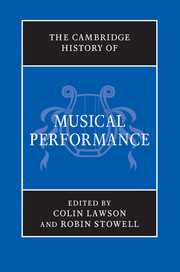Book contents
- Frontmatter
- PART I PERFORMANCE THROUGH HISTORY
- PART II PRE-RENAISSANCE PERFORMANCE
- PART III PERFORMANCE IN THE RENAISSANCE (C. 1430–1600)
- PART IV PERFORMANCE IN THE SEVENTEENTH CENTURY
- 16 Performance in the seventeenth century: an overview
- 17 Vocal performance in the seventeenth century
- 18 Instrumental performance in the seventeenth century
- 19 Case study: Monteverdi, Vespers (1610)
- PART V PERFORMANCE IN THE ‘LONG EIGHTEENTH CENTURY’
- PART VI PERFORMANCE IN THE NINETEENTH CENTURY
- PART VII THE TWENTIETH CENTURY AND BEYOND
- PART VIII
- Index
19 - Case study: Monteverdi, Vespers (1610)
from PART IV - PERFORMANCE IN THE SEVENTEENTH CENTURY
Published online by Cambridge University Press: 28 March 2012
- Frontmatter
- PART I PERFORMANCE THROUGH HISTORY
- PART II PRE-RENAISSANCE PERFORMANCE
- PART III PERFORMANCE IN THE RENAISSANCE (C. 1430–1600)
- PART IV PERFORMANCE IN THE SEVENTEENTH CENTURY
- 16 Performance in the seventeenth century: an overview
- 17 Vocal performance in the seventeenth century
- 18 Instrumental performance in the seventeenth century
- 19 Case study: Monteverdi, Vespers (1610)
- PART V PERFORMANCE IN THE ‘LONG EIGHTEENTH CENTURY’
- PART VI PERFORMANCE IN THE NINETEENTH CENTURY
- PART VII THE TWENTIETH CENTURY AND BEYOND
- PART VIII
- Index
Summary
Monteverdi's Vespers is probably the most popular ‘piece’ of early seventeenth-century sacred music nowadays – certainly in terms of performances and recordings. The inverted commas around ‘piece’ are deliberate for, although many perform this sequence of Vespers music as a single work within a church or concert hall, there is little doubt that Monteverdi saw his 1610 publication as an all-purpose collection designed to be dipped into rather than performed from beginning to end. As well as the Vespers music (including two Magnificats) the volume contains a Mass; moreover, the music is written for a wide range of scorings which suggests that it was probably composed at different times and was not originally intended as a ‘work’ in the modern sense. That is not to say, however, that the modern tradition of performing Monteverdi's Vespers as a single work is not viable or desirable. The music (with or without additions) makes an ideal concert in terms of length and sheer variety – not to mention quality – of music. That performers and academics alike are fascinated by this ‘work’ is therefore not surprising and, as Monteverdi's 1610 collection raises virtually every important issue in relation to the performance practice of early seventeenth-century sacred music, it is an ideal subject on which to base this chapter.
In order to examine the range of performance possibilities for the 1610 Vespers, it is necessary to refer to the original musical notation, to music treatises, and to a large range of recent scholarship. It would be foolish to expect this material to deal with all the questions, but it does at least offer the beginnings of some answers for performers approaching the music today. Reference is made to a number of representative recordings of the 1610 Vespers in order to demonstrate modern-day practices and trends.
- Type
- Chapter
- Information
- The Cambridge History of Musical Performance , pp. 448 - 470Publisher: Cambridge University PressPrint publication year: 2012

